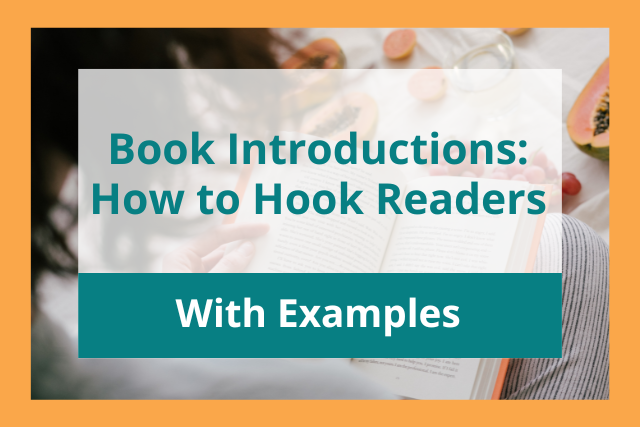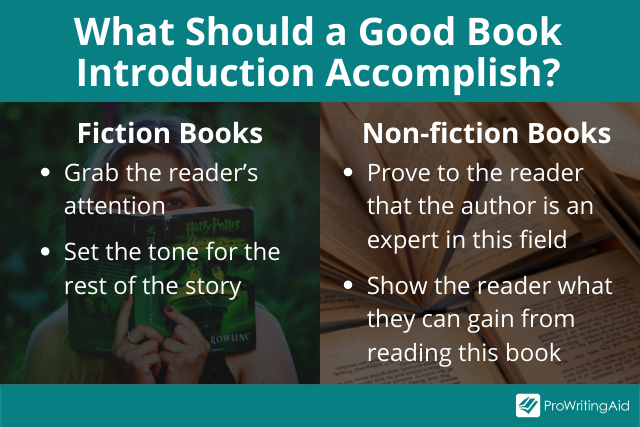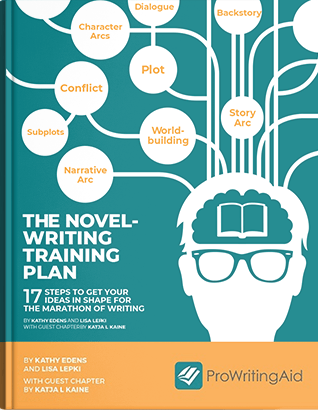
If you want readers to buy your book, it’s important to make a great first impression.
Your book's introduction should prove to the reader that this story can offer them what they’re looking for, whether that’s wisdom, entertainment, or anything in between.
So what are the different book introductions, and how do you write an effective one?
This article will explain how to write a fantastic book introduction that hooks your readers in.
What Is an Introduction in a Book or Story?
The introduction is the first section of a book.
In a nonfiction book, the introduction should show the reader why this author is an expert in this field and what the reader can expect to gain from this book.
In a fiction book, the introduction should grab the reader’s attention and set the tone for the rest of the story.
Either way, the introduction must convince a reader to invest time and money into reading this particular book, rather than all the other options in the bookstore.

There are many types of book introductions, such as prefaces, forewords, and prologues. So before we jump into our advice for writing an introduction, let’s start with a quick overview of what these different types are.
Brief Explanation of a Preface
A preface is an introductory essay written by the author of a nonfiction book.
You can use the preface to explain why you’re the right person to write about this book’s specific subject matter.
You can mention your educational background, your life experience, your teaching experience, or any other credentials that will show readers you’re an expert in the field.
You can also talk about your motivations for writing this book. For example, if there was a specific event or situation that inspired you to explore this topic in greater depth, the preface is the right place to give your readers all the necessary context around how this book was formed.
Brief Explanation of a Foreword
A foreword, like a preface, is also an introductory essay at the beginning of a nonfiction book. Unlike a preface, however, a foreword is not written by the author of the book. Instead, it’s written by a different expert in the field.
The main purpose of a foreword is to lend extra credibility to the book. It’s a marketing tool, just like the blurbs from other authors that might be on the book’s cover. Readers will see this endorsement from a prominent figure as a vote of confidence in the book’s reliability or importance.
Forewords can also be used when a new edition of a previously published book releases in order to give the new edition a fresh perspective. For example, a new edition of a classic 20th-century book might come with a foreword from a modern expert to give context to modern readers.
Brief Explanation of a Prologue
A prologue is an introductory passage found at the beginning of fiction books. Not all fiction books have a prologue, but there are many reasons you might decide to include a prologue in your novel.
One common reason to include a prologue is to give the reader background information on events that take place before the main story begins.
For example, high fantasy novels often use a prologue to tell the reader the history of the world’s politics, or the prophecy that the hero will later fulfill, or something else along those lines.
You can also use a prologue to establish the tone of the book upfront and show readers what they can expect later in the story.
For example, in mystery and thriller books, authors might use an action-packed prologue to show readers that this will be an exciting and fast-paced book, even if the first chapters are slower and quieter.
Great Book Introduction Examples
Let’s look at some examples of some fantastic book introductions in each of the above categories.
The Preface of A Promised Land by Barack Obama
A Promised Land is a memoir that chronicles the presidency of U.S. President Barack Obama.
In the preface, Obama gives the context behind the book. He tells the reader that he started writing A Promised Land on his last flight on Air Force One, determined to create a lasting record of his time in office and show people what it’s like to be the president of the U.S.
This preface was so successful that it was widely excerpted and printed on its own, and it even reached people who didn’t read the rest of the book.
The Foreword of How to Win Friends and Influence People by Dale Carnegie (2022 edition)
The first edition of How to Win Friends and Influence People, a motivational guide to help people interact with others more effectively, was published in 1936. It quickly became one of the best-selling books of all time, with over 30 million copies sold worldwide.
In 2022, a new edition was released with a foreword written by Dale Carnegie’s daughter, Donna Carnegie, with updates to keep it fresh for modern readers. In the foreword, Donna Carnegie explains the impact her father’s book has made on the world and also describes the process she used to update the book while preserving his original vision.
The Prologue of Jurassic Park by Michael Crichton
Jurassic Park is a science fiction book about a theme park filled with dinosaurs. This book has two prologues, and each one is effective at accomplishing a different goal.
The first prologue is a simple, straightforward passage that summarizes the technology available on Earth by the time this book takes place.
It’s useful because it gives the reader the background information they need to understand how a place like Jurassic Park can exist.
The second prologue is a short, exciting scene in which a side character gets bitten by a mysterious monster.
After all, readers of Jurassic Park are expecting exciting scenes with dinosaurs. The problem is that the dinosaurs don’t show up many chapters into the story, after the main characters arrive at Jurassic Park.
That’s why this second prologue is so effective. It gives the readers a taste of the excitement they’re looking for and promises that there will be a terrifying monster in this book, which gives enough tantalizing foreshadowing to last the readers until the main characters get to the park.
5 Tips for Writing the Best Book Introductions
So what exactly are the steps you can take to write an amazing book introduction, like the ones we looked at in the previous section?
Here are our top tips.
Tip 1: Write the Introduction Last
This tip may feel counterintuitive, but just because the introduction is the first part of the book, doesn't mean it has to be the first step in your writing process.
Writing introductions is one of the most challenging parts of being an author, since it can be daunting to take on a blank page. There's also a lot of pressure to make the opening pages perfect.
As a result, it’s often helpful to take the pressure off by saving the introduction for the very end, after you’ve written the rest of the book.
You also get the added benefit of knowing more about the book than you did before you started, so you can incorporate all that extra wisdom and knowledge into the introduction, as well.
Tip 2: Craft a Strong First Sentence
You should aim to intrigue readers as quickly as you can—ideally, in the very first sentence.
Here are some examples of intriguing first sentences in fiction:
- “It was her idea to tie up the nun.”—Patricia Engel, Infinite Country
- “Edward Fosca was a murderer.”—Alex Michaelides, The Maidens
- “Call me Ishmael.”—Herman Melville, Moby Dick
Here are some examples of intriguing first sentences in nonfiction:
- “Bob Dylan looks bored.”—Jonah Lehrer, Imagine: How Creativity Works
- “Thomas Jefferson was a lifelong and habitual fretter.”—Rachel Maddow, Drift: The Unmooring of American Military Power
- “In the fall of 1993, a man who would upend much of what we know about habits walked into a laboratory in San Diego for a scheduled appointment.”—Charles Duhigg, The Power of Habit
It’s not just about the first sentence, of course. You’ll have to keep the reader hooked throughout the rest of the book, too. But a great first sentence is a tool you shouldn’t overlook.
Tip 3: Identify and Address the Reader’s Needs
If you’re writing a nonfiction book, you can use the book introduction to describe the reader’s needs explicitly. Why would a reader pick up a book like yours? What problems in their lives could your book help them solve?
For example, if you’re writing an introductory guide to computer programming, you might say outright, “Perhaps you’ve spent years wanting to create your own website. Maybe you’ve even tried a programming language or two but never quite got the hang of it.”
In a fiction prologue, you should also address the reader’s needs, but in a more subtle way.
For example, an ideal reader who picks up a horror book might need to feel scared, thrilled, and excited.
An ideal reader who picks up a humor book might need to feel amused, cheered, and uplifted. Create a prologue or first chapter that promises to deliver on those needs.
Tip 4: Set the Tone for the Book
If your book is serious and somber, the introduction shouldn’t be flippant and witty. On the other hand, if your book is casual and conversational, the introduction shouldn’t be overly formal.
Make sure that the tone of the introduction matches the tone of the rest of the book, so you don’t surprise the reader later on.
Tip 5: Keep It Short and Sweet
Long introductions are the quickest way to bore a reader and tempt them to put the book down.
If you’re writing a prologue, for example, it’s important not to cram in every detail about the history of the world or the backstories of the main characters.
And if you’re writing a preface, you don’t need to describe your entire life story or summarize the entire book for the reader.
Pick and choose the most important and enticing details, the ones that the reader absolutely needs to know. Leave some open questions so the reader still wants to read more.
Should You Use Different Book Introductions for Different Genres?
Different genres have different guidelines and conventions. As a result, it’s important to research the book introductions that are common in the specific genre you’re writing.
For example, prologues are common in science fiction and fantasy novels because these stories are often set on worlds different from our own.
The prologue is a great chance for the author to introduce readers to this new world and give them the context they need before the story begins.
On the other hand, literary novels don’t normally include prologues, instead choosing to jump right into the story.
That doesn’t mean you can’t use a prologue in a literary novel: it just means it might be a harder sell for readers and publishers, since they won’t be expecting to see one.
You can go to your local bookstore, find the shelf that your book would sit on after publication, and read the introductions of the other books on that shelf. This exercise will give you a sense of what’s common in your genre and how you can use or subvert those conventions.
Conclusion on Book Introductions
There you have it—our complete guide for how to write a book introduction that will grab your reader's’ attention from the very first page.
Good luck, and happy writing!


